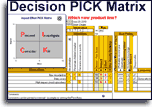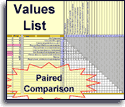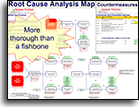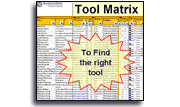Installation and Setup
Installation - Each User. Installation - Multi-user. Language Translations. Personalize Your Templates.Systems2win Training.
Quick Start Initial Training. New User Training. Training Matrix. Systems2win Leadership. Training Classes.Lean Training
Lean Training and Coaching. Lean Principles. Muda 8 Wastes. Goal - Lean Flow. Roadmap - Lean Journey. Value Stream Mapping. Standard Work. Hansei Lean Thinking. Lean Dictionary. Online Lean Training. Lean Leadership.Microsoft Office Training
Excel Training. Excel Drawings (without Visio). Excel Charts. Word Training. PDF Training. Document Storage and Naming.Support
Support.Project Prioritization Matrix
Project Prioritization template for Priority Matrix Project Management
Project Priority Matrix
for Lean Six Sigma Opportunity Analysis
One popular use for your decision making template
is to analyze, select, and prioritize Lean Six Sigma projects

What should we work on next?
How to use your
Project Prioritization template
Choose the right project priority matrix template
The training on this page assumes that you are using your Decision Matrix Quadrant Chart (DecisionPICK.xlsx) for the purpose of selecting and prioritizing Lean Six Sigma projects
You might, however, choose to use one of your other decision making tools for either more or less thorough decision making analysis.

Follow the usual instructions for how to use your template
When you get to the steps where you choose factors affecting Impact and Effort...
then the training on this page will give you lots of ideas for factors that you might consider.
Project Priority Matrix
Project Selection Criteria — Impact
Potential Objectives for Lean Six Sigma Projects
After coming up with a long list of potential Objectives
(perhaps using brainstorming methods and/or your Values List template...)
then narrow down your list of Impact Objectives, using the following list of potential considerations:
Customer Impact
Contribution to customer Critical to Quality factors.
Most of your objectives should come from your 'Critical To' analysis.
Critical To Quality, Critical To Delivery, Critical to Customer Satisfaction...
Are the expected benefits significant enough?
Perhaps use your templates for Voice of the Customer Analysis
Are there direct measurable benefits to specific key customers?
Itemize them.
Financial Impact
Ideally both hard dollars and soft dollar impacts from customer satisfaction.
Urgency
Is there a burning platform?
Are customers complaining or defecting?
Don't artificially invent a burning platform, but if you face an honest potential crisis... use it for motivation.
Do all stakeholders agree this is a major problem?
Perhaps use your templates for stakeholder analysis.
Alignment with Strategic Objectives
Synergy (or conflict) with other existing and proposed initiatives.
How does each proposed Alternative contribute to this team's Hoshin Plan?






SWOT Analysis
How well does this project use or contribute to Strengths?
Avoid or shore up Weaknesses?
Take advantage of Opportunities?
Avoid or alleviate Threats?
Clear Scope and Boundaries
How well is the Project Charter scoped?
What are the risks that the scope of this project will creep?
Specific and Measurable
Are all Objectives and Targets narrowly defined, and objectively measurable?
Not 'improve delivery time', but perhaps 'average 2 day lead time'.
Not 'reduce defects', but perhaps 'specific defect < 10 pmo'
Project Prioritization Matrix
Project Prioritization Criteria — Effort
Potential Factors affecting Achievability
The very first instruction for using your Decision Matrix template
is to use the dropdown list to choose either:
- Impact Effort, or
- Effective Achievable

The following list of potential factors affecting Achievability assumes that you chose 'Effective Achievable'.
If your chose 'Impact Effort', then you will need to rephrase all criteria so that a lower score is more desirable.
Lower Effort is more desirable.
Higher Achievability is more desirable.
Enthusiasm of Leadership
Enthusiasm of Executive Sponsor Change Agent
Enthusiasm of Project Leader and Team
Enthusiasm of all Stakeholders affected by the project
Or stated the opposite for 'Effort'...
How much effort might be needed to counter potential resistance?
Again... use your Change Management tools
Team Availability
Who is needed for which proposed Alternatives?
What is their availability?
Resource Availability
What resources are needed?
What is their availability?
How much investment is needed?

How easy is it to turn your ship?
Data Availability
What data is needed?
Does that data exist?
How easily can it be obtained?
Use your Voice of the Customer Data Collection template
Control of Variables and Risks
To what degree does this team have control over the possibility that the project will not yield desired results?
Customer? Nature? Are all variables known?
Will a cross-functional team be required? Are all areas of the value stream adequately involved and committed?
Stability
Is this process stable?
Not just SPC, but also consider leadership and other factors.
Is it expected to remain stable?
Or are potential changes on the horizon?
If not stable... then the only acceptable type of project is a 'Just Do It'.
See types of projects below.
Probability of Successful Implementation
Anything other factors that might affect successful implementation?
Sustainability?
Return to Decision Matrix training
Project Prioritization
Project Type
Additional Considerations
At the bottom of your Impact Effort Matrix there is a section for 'Other Considerations'
In addition to Impact and Effort, another major consideration is...
What type of approach might be best for each proposed project?
You can easily define your own dropdown list of your own project types
on the DV sheet...
(the same way that you define dropdown lists in all of your other 150+ templates)
Types of Lean Six Sigma Projects
Just Do It
Purposes:
To quickly implement an obviously good idea perhaps using your One Good Idea template or perhaps using Jidoka swarming or perhaps just handle it as part of Leader Standard Work
If there is already an obvious good solution then JDI is the only correct approach.
Every one of the other approaches (listed below) are only appropriate if there is doubt that an initial 'shoot-from-the-hip' proposal might not turn out to be the best solution after all.


Value Stream Event
Purposes:
To improve flow between processes in a value stream, and accomplish any or all of the other purposes of value stream mapping

Lean Methods
Purposes:
To improve flow within each process and accomplish any or all of the other purposes of lean process improvement
If your value stream has not yet passed the acid test for lean transformation, then there really shouldn't be any debate.
Your priorities for that value stream should be focused on lean flow, visual management, and standard work.
If you don't have those things in place, then anything else that you try is just going to soon be a distant failed memory anyway... so why start?


DMAIC Quality Improvement
Purposes:
To improve reliability and quality using the DMAIC method and Six Sigma tools
If your problem is complex enough to require a certified Black Belt because you suspect interrelationships between multiple Y variables, then it's time to dig in and authorize the time and cost of a lengthy, complicated Six Sigma project.
If there are any simpler hypotheses that might be resolved using the Green Belt level Seven Basic Tools of Quality... then try those first!


Design for Six Sigma
Purposes:
To develop a new or improved product or service perhaps using the DMADV method and DFSS tools or perhaps using Process Engineering or (most commonly) using DFMEA and PMFEA

Root Cause Analysis
Purposes:
To identify root causes of a problem
If there is not yet consensus about root causes, then it is often wise to authorize a project with the scope limited to the mission of identifying root causes... before authorizing a larger project to 'solve the problem'.
After thorough Root Cause Analysis, the subsequent 'solution' phase might be a simple 'Just Do It'.

A3 Problem Solving
Purposes:
To thoroughly and systematically solve an important problem
If your organization is going to use only one problem solving method, then A3 problem solving is probably the right choice.
It is flexible, robust, and time-efficient, and is easily monitored and managed.

Kaizen Event
Purposes:
To radically improve a process in a very short amount of time
If you have the luxury of locking several high-level people in a room for several days then the best way to make big changes quickly is a Kaizen Event.

Lengthy Project
Purposes:
Traditional project management tools If you need to move facilities, or merge and acquisition, or plan the Christmas party...
the Gantt Chart is not dead.

Training & Education
Purposes:
To increase awareness and competence with Lean Training & Education
To train and mentor people to do things the same way every time
(whether or not your organization is officially ISO 9000 certified)

Process Improvement Programs
In addition to the types of Lean Six Sigma projects (listed above), many organizations also have on-going Process Improvement Programs
They are on-going... endless... They don't have a defined ending.
Strategic Planning & Alignment
Purposes:
To do periodic strategic planning, (perhaps at multiple Hoshin levels), and then to effectively coordinate and deploy those strategically aligned initiatives.

Improvement Kata / Coaching Kata
Purposes:
To consistently and systematically apply PDCA problem solving throughout multiple layers of management.
We reluctantly put this in the 'Programs' section because each new Strategic Objective is essentially a mini-project, but one of the primary differences of the Kata approach is that it tends to be deployed with quasi-religious fervor, and the instant that one problem is solved, each team is encouraged to actively seek another new target


5S
Purposes:
To establish habits and culture to reveal problems
Hidden problems can't be solved and 5S is usually a cornerstone program in most lean organizations

Preventive Maintenance
Purposes:
To identify, reduce, and eliminate causes of downtime
TPM is usually an ongoing program; not a one-time project.

Lean Management Systems
Purposes:
To coach and develop lean leadership using Lean Management Systems


Task Prioritization
Once you have selected your projects, you need to manage them.
Your Systems2win templates also empower you with several Project Management Tools
to prioritize and manage tasks in several popular, field-proven ways.
Project Prioritization template
and 150+ templates to empower your team leaders
to lead ANY type of project or program for process improvement

Similar, familiar tools for
Continuous Improvement
Own Yours Now
If your organization has
not yet provided a license,
own yours now

No, we're not going to
buy you any tools...
but we don't want any excuses when those deadlines are due
Own Yours Now
Own your own professional tools
that you can take with you for the rest of your career
Training and Coaching
Consider Training and Coaching to support your teams to succeed

Training to get you started.
Tools you won't outgrow.
Schedule a Conference
Schedule a conference
to discuss your challenges
with an experienced lean advisor
Download Trial Now
Get a dozen trial templates,
and another dozen free gifts
@@@ Better conversion rate
if call to action is for a specific tool, and shows the image

Try It
Try this template
along with a couple dozen more
process improvement tools
Calls to Action Botttom
Related Topics
Related Topics section WITHOUT TESTIMONIALS
Replace this paragraph with menu library item for topics related to this video
Training and Coaching
Consider Training and Coaching to support your teams to succeed

Training to get you started.
Tools you won't outgrow.
Schedule a Conference
Schedule a conference
to discuss your challenges
with an experienced lean advisor















